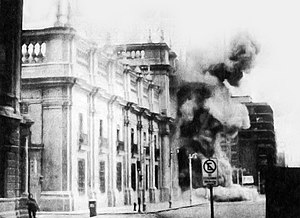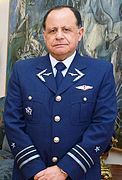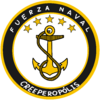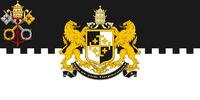2003 Creeperian Coup d'État
| 2003 Creeperian Coup D'état | |||||||
|---|---|---|---|---|---|---|---|
 The bombing of the San Salvador Imperial Palace on during the coup by the Creeperian Air Force. | |||||||
| |||||||
| Belligerents | |||||||
|
|
| ||||||
| Commanders and leaders | |||||||
|
|
| ||||||
| Strength | |||||||
| 302 soldiers |
1,200,000 soldiers 300 tanques 5,000 artillery pieces 50 ships 100 aircraft | ||||||
| Casualties and losses | |||||||
| 302 dead | 17 dead | ||||||
| 319 in total during the coup | |||||||
The 2003 Creeperian Coup D'état was a civil military operation which deposed the four year-long totalitarian regime led by Emperor Alfonso VI. The coup was carried out on June 18, 2003 and was led by the future Emperor Alexander II and Creeperian Army Chief Field Marshal Augusto Cabañeras Gutiérrez.
The Creeperian Initiative supported the coup and transferred leadership to Alexander II. Alexander II remains in power to this day.
The coup maked a watershed moment in Creeperian history and began the true modernization of the nation and the growth of its economy.
Background
Political and Military Situation
On October 16, 1999, Emperor Romero III died without an heir. This left his younger brother, Alfonso VI, to become Emperor. Alfonso VI took the absolute nature of the monarchy to an extreme and ushered in an era known in Creeperian history as the October 16 Regime. The regime was known for its totalitarian nature. Alfonso VI cut funding and numbers to the National Intelligence Directorate (abbreviated DINA, the Creeperian secret police) and also reduced funding to the three major brances of the Creeperian Armed Forces: the Army, Navy, and Air Force. The cut funding went to his own private spending and to the Creeperian Imperial Guard as a way to assure himself a long, comfortable, and luxurious reign with no fear of being toppled or assassinated.
The massive cut in funding angered all three major branches of the Creeperian Amred Forces. Emmanuel Cabañeras Videla, the Chief Field Marshal of the Army, the Minister of Defense, and the Chief of the DINA (all since 1976), was the most enraged of the three commanders, the others being Chief Admiral José Guerrero López of the Navy and Chief General Felipe Cambeiro Cavallería of the Air Force.
Alfonso VI saw that his Minister of Defense, his second-in-command and right hand man, was showing several signs of disloyalty and anger with his regime. Wishing to eliminate any possibility of a coup, Alfonso VI began planning the removal of Cabañeras Videla. On October 22, 2002, Emmanuel Cabañeras Videla was found dead in his mansion which was inherited through his father, Alfonso Cabañeras Moreno. The official autopsy found that Cabañeras Videla had died of a heart attack. However, many believed that he was, in fact, assassinated on orders of Alfonso VI as a way to eliminate any chance of a coup. (After the coup, the government officially labeled Cabañeras Videla's death as an assassination by cyanide poisoning.)
With his greatest potential rival and threat eliminated, Alfonso VI elevated his former Minister of Defense's son, Augusto Cabañeras Gutiérrez, as the next Minister of Defense, Chief Field Marshal, and Chief of the DINA. Alfonso VI believed that Cabañeras Gutiérrez would be more loyal than his father and predecessor as he had given him vasts amounts of bribes in the form of direct cash, luxurious vehicles, and even gold from the treasury. He gave the same bribes to Guerrero López and Cambeiro Cavallería to keep their loyalty.
Meanwhile, the Chief Guard of the Creeperian Imperial Guard, Armando Figueroa Molina, was showered with the greatest bribes, riches, and rewards for his constant loyalty to the regime. From 1999-2003, the Imperial Guard, which had always been regarded as the least important of the four branches of the armed forces, had begun to grow in power and influence in the government, in tern, diminishing the power of the army, navy, and air force over time.
Planning the Coup
Beginning in February 2003, Cabañeras Gutiérrez, Guerrero López, and Cambeiro Cavallería began meeting in secret to discuss a possible plot to overthrow the regime. The three knew that there were three major problems standing in the way of a successful coup. The first was the Imperial Guard, but it was regarded as a non-factor in the end as they know that a coup against the Imperial Guard is possible as it has been accomplished multiple times (ie. 1550 Creeperian Coup D'état, Monarch's Revolution, Revolution of 1833, etc.).
The second major problem the conspiracy faced was the reaction of the State of the Church and the Pope, at the time John Paul II. The three did not want to lose the trust and support of the Creeperian Catholic Church as the body has a massive influence over Creeperian culture and society in general. Upsetting the Church was an easy way to lose faith with the people and possibly put the conspirators at risk of being overthrown themselves or beginning a second civil war. Creeperopolis was already unstable enough as it was at the time and the three did not want to make the situation worse.
The third, and probably the greatest threat to the plot, was the people of Creeperopolis. The three men had no idea how the Creeperian people would react to the overthrow of their government. The three believed the regime to be unpopular, but there was no real way to find out at the time. They, however, knew how to gain the support of the people.
The three approached the eldest son of Alfonso VI, Grand Prince Alexander Martínez Hernández, and asked him if he wished to join in on the plot to depose his father. After a large bribe and promises of power, Alexander Martínez Hernández joined aboard the plot.
With the likely approval of the people secured, the comspirators needed the approval of the Church. The three approached John Paul II and pleaded their case against Alfonso VI. They presented evidence of totalitarianism and used evidence of their own war crimes, but labeled as the crimes of the regime itself, as evidence against Alfonso VI. After a month of appeals and persuasion, the conspiracy recieved the support of the Church in late May 2003.
With all the support they need, each commander spoke to their respective soldiers to recruit them to the coup. After the military itself was brought onboard, a date was schedualed: June 18, 2003, would be the day the Creeperian Armed Forces overthrow the government of the Holy Traditionalist Empire of Creeperopolis.
Coup
Conspirators
Army
The coup to topple the totalitarian regime of Alfonso VI began on the command of Augusto Cabañeras Gutiérrez at 9:11am, San Salvador Time (SST), on June 18, 2003. The coup started with the I and II Creeperian Army Corps moving into positions to surround the city of San Salvador, followed by the III through XI Creeperian Army Corps setting up offensive positions in the city near the San Salvador Imperial Palace. The XII Creeperian Army Corps was stationed at the Alfonso I Martínez International Aiport. The División Negra, the elite of the Creeperian Army, was ordered to surround the Imperial Palace and to prepare for a storming of the Palace.
The V Creeperian Army Corps was ordered to begin the artillery shelling of the Imperial Palace at 9:58am. At 10:00am, the Army siezed a radio station in San Salvador and sent a broadcast to the nation saying:
"Do not fear faithful Creeperans. This is not a malicious nor foreign nor [Senvarian] takeover of the Fatherland or toppling of the government. Instead, the Armed Forces of the [Creeperian] Fatherland and the [Creeperian Catholic] Church have witnessed the totalitarianism of the regime of Alfonso VI. Under the guide of the Lord God, we are removing this wicked government from power and are installing a truthful, honest, and benevolent government, a new Emperor on the Imperial throne from the line of Martínez. Long live Creeperopolis! Long live the Fatherland! Long live God!"
The Army was then ordered to storm the Palace and to offer no quarter to the Imperial Guards who have "betrayed the Fatherland" (after the Air Force and artillery completed bombing the Palace). The guards were ruthlessly massacred by the Army, with an estimated 302 being slaughtered.
Air Force
Alexander Martínez Hernández
Leaders of the Coup
- A. Pinochet Stamp cropped.jpg








